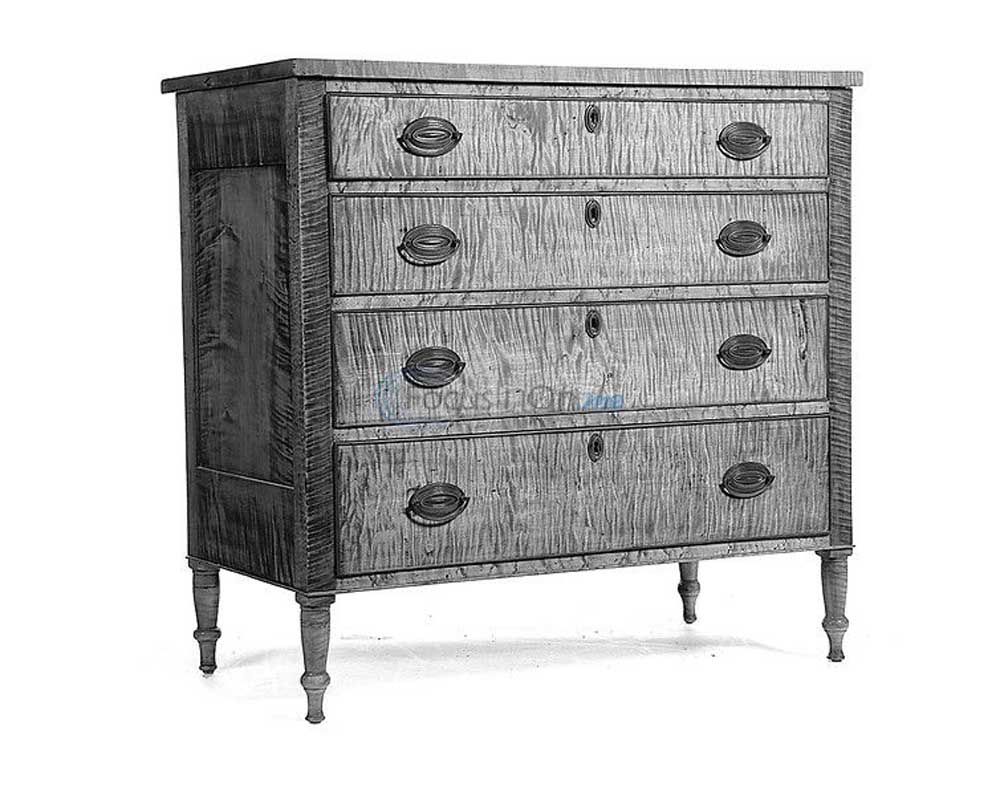Maple can yield striking designs, helping furniture hold its value
Published 10:18 pm Monday, July 20, 2015
What is now called “brown furniture” is not selling for high prices any more. Even unusual pieces made of rare wood are out of favor in most parts of the country.
But low auction and shop prices mean there are bargains to be had. The antiques are well made of solid wood, and although already almost 200 years old, probably will be useful for another hundred or more.
Curly maple is an uncommon wood used by early craftsmen in Ohio and parts of New England where the soft maple trees were plentiful. It is also called flame maple, tiger maple, ripple maple, fiddleback maple or tiger stripe. The unusual, decorative grain seems almost three-dimensional as it “curls” the length of the board. It is best seen when the board is quartersawn and may not show at all in a flatsawn board.
It is thought that this pattern appears in the wood because of something in the environment. It is not caused by a disease.
A related figured wood is known as bird’s eye maple. It has the same glowing figure, but it swirls to look a bit like eyes. It appears in some hard maple trees if they’re cut the right way. In the 1930s to 1980s, furniture with curly maple veneer was considered special by collectors and prices were high. A good Sheraton chest of drawers could bring $2,000 to $3,000, and an exceptional chest might sell for more than $5,000. Even refinished, a curly maple chest probably will hold its value, and because it is rare, become even more expensive in the future.
SILVER PLATE
Q: About 25 years ago, I found a sterling-silver plate at a sale. It was in a cloth bag labeled “John Wanamaker, Jewelers & Silversmiths.” The plate is marked with the initials “JW” on one side of an eagle, and “925” over “1000” on the other side. John Wanamaker’s department store was a Philadelphia landmark, but did it also make silver?
A: John Wanamaker opened a men’s clothing store in Philadelphia with his brother-in-law in 1861. After his brother-in-law died, Wanamaker expanded the business into an upscale department store. Some items, like your silver plate, were made for Wanamaker’s by other companies. The numbers “925” over “1000” are the standard for sterling silver in the United States and many other countries. Wanamaker’s became part of Hecht’s in 1995, which is now part of Macy’s.
BATES BEDSPREAD
Q: My mother had a tufted bedspread in her 1940s college room. She called it a Bates bedspread, but didn’t know its history. Can you help?
A: The Bates bedspread was first made more than 150 years ago. Bates Manufacturing Co. started in Maine in 1850, and first made bedspreads in 1857. During the Civil War, Mr. Bates bought cotton for the Union army. The company prospered and in 1940 introduced “George Washington’s Choice,” a design inspired by a bedspread Washington gave his wife. That pattern is still made. Many old spreads have been given to the next generation. College spreads were so popular with students, the company made a series of designs inspired by history and presidents. The company is still making bedspreads in the U.S. Vintage bedspreads were made from 100-percent cotton on old shuttle looms. The fringe and other finishing was done by hand. Early 1900s spreads had a woven label. Later labels were printed. In the 1960s, bright colors were used for the woven parts and a contrasting color for the fringe. And remember, the original box adds value.
WALL CLOCK
Q: I’d like to sell a wall clock I’ve had since 1968. I think it’s rosewood. The top section with the clock face is octagonal. The lower section has a small glass door that shows the pendulum. It looks like a Regulator clock, but the bottom is shorter. The dial is white with Roman numerals surrounded by Arabic numerals 1 through 31. The back is marked Gilbert Clock Co. What are the extra numbers for? What is it worth?
A: You have a “short drop” Regulator calendar clock called a “schoolhouse” clock. The style was widely used in schools and post offices, shops and other public places. Your clock has a calendar hand that indicates the day of the month on the Arabic numbers. William L. Gilbert (1806-1890) was involved in clock making companies in Bristol, Farmington and Winsted, Connecticut, beginning in 1828. After various partnerships and a factory fire, he formed the William L. Gilbert Clock Co. in Winsted in 1871. The company made inexpensive clocks. Cases usually were oak or rosewood. Gilbert died in 1890, but the company name was used for 63 more years. After the 1930s Depression, the company reorganized. It was sold in 1964. Your clock was made about 1880 and would sell for $120 to $175.
Terry Kovel and Kim Kovel answer questions sent to the column. Write to Kovels, Tyler Morning Telegraph, King Features Syndicate, 300 W. 57th St., New York, New York, 10019.
(Cutline for July 19, 2015)
COWLES SYNDICATE INC.
NOTICE THE PATTERNED WOOD on the front of this Sheraton chest of drawers, made about 1840. It has a two-board top, turned legs and old brass handles. The four drawers make it a useful bedroom or even dining-room piece with storage space. In May it sold at a Garth auction in Delaware, Ohio, for $3,000.







